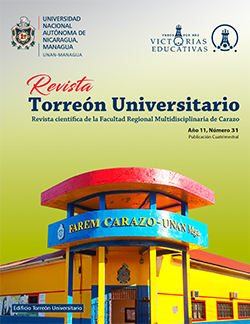Balance of the External Dosimetry service of the LAF-RAM during the year of Covid19. Is there an incidence in the doses of TOE?
DOI:
https://doi.org/10.5377/rtu.v11i31.14226Keywords:
Dosimeter, Occupationally exposed worker, Personal dosimetryAbstract
A protocol for the prevention of COVID-19 was established to maintain the continuity of the external dosimetry service, which is applied to both laboratory personnel and customers. The evolution of the dosimetry service at the national level between 2019 and 2020 was compared in terms of the number of institutions attended and the number of users, as well as a possible increase in the personal dose equivalent. The COVID-19 pandemic generated a decrease in the number of institutions served in the last quarters evaluated, but not in the number of dosimeters read by the service. There was an increase of 1, 1 times in the average personal equivalent dose in 2020 concerning 2019, without exceeding the dose restrictions. There was no absence of LAF-RAM technical personnel, therefore, the dosimetry service was maintained without interruptions, considering the adopted protocol to be adequate.
Downloads
References
Asamblea Nacional de Nicaragua. (1993, 23 de marzo). Ley 156 de 1993. Ley Sobre Radiaciones Ionizantes. La Gaceta nº 73. https://www.lagaceta.gob.ni/1993/04/073/
Burcin, O., Hajek, M., Abutalipov, R., Vanhaver, F., & Carinou, E. (2020). Continuity in COVID-19 pandemic: How to run effective technical services for individual monitoring during a pandemic [Webinar]. International Atomic Energy Agency IAEA. http://ns-files.iaea.org/video/orp-webinar-may2020.mp4
Comisión Nacional de Energía Atómica CONEA. (2011, 12 de octubre). Reglamento técnico de protección contra las radiaciones ionizantes de la república de Nicaragua. Reglamento técnico de protección contra las radiaciones ionizantes (minsa.gob.ni)
Consejo de Seguridad Nuclear CSN Guía de Seguridad No.5.11 (1990). Aspectos técnicos de Seguridad y Protección Radiológica de Instalaciones Médicas de Rayos X para Diagnóstico. Aspectos técnicos de seguridad y protección radiológica de instalaciones médicas de rayos X para diagnóstico (sne.es)
Laboratorio de Física de Radiaciones y Metrología. (2020). Manual de Caracterización de Procesos. [Manuscrito no publicado]. Universidad Nacional Autónoma de Nicaragua, Managua.
Organismo Internacional de Energía Atómica. Requisitos Generales de Seguridad parte 3. (2016). Protección radiológica y seguridad de las fuentes de radiación: Normas básicas internacionales de seguridad. https://www-pub.iaea.org/MTCD/publications/PDF/P1578_S_web.pdf
Organización Mundial de la Salud (OMS). (2020). Manual de orientación rápida para la utilización de estudios radiológicos de tórax en el diagnóstico de la COVID-19, 11 de junio de 2020.
Organización Mundial de la Salud. https://apps.who.int/iris/handle/10665/333776
Organización Mundial de la Salud (OMS). (s.f.). Brote de enfermedad por coronavirus (COVID-19): orientaciones para el público. Consultado el 30 de marzo de 2021. https://www.who.int/es/emergencies/diseases/novel-coronavirus-2019/advice-for-public
Rubio Hurtado, M. J. y Berlanga Silvente, V. (2012). Cómo aplicar las pruebas paramétricas bivariadas t de Student y ANOVA en SPSS. Caso práctico. REIRE, Revista d’Innovació i Recerca en Educació. 5(2), 83-100. http://www.ub.edu/ice/reire.htm
Vecchio, A. (2020). COVID-19-Related Issues: A Medical Physics Perspective from Italy. [Webinar]. Departamento de Física Médica, Instituto Científico San Rafael. https://mpwb.org/CoronaVirusResources
Published
How to Cite
Issue
Section
License
Copyright (c) 2022 National Autonomous University of Nicaragua, Managua.

This work is licensed under a Creative Commons Attribution-NonCommercial-NoDerivatives 4.0 International License.
The authors who publish in this journal agree to the following terms.
- The author or authors of the articles, essays or research grant the National Autonomous University of Nicaragua, Managua (UNAN-Managua) the editing rights (copyright) of the submitted work, therefore the University has the exclusive right to publish the article for the entire copyright period.
- These copyrights/authors authorize Torreón Universitario Magazine and the University to edit and disseminate/publish the article in said Magazine, including printed and electronic reproduction, storage, retrieval and any other type of publication, and sources of secondary information as services. of summaries and databases, they also empower it to protect the article against unauthorized use for dissemination by printed or electronic media (PDF, HTML, EPUB, XML or others).
License for use of content
The magazine uses the Creative Commons Attribution-NonCommercial-NoDerivs 4.0 International License.
Under this statement:

This journal is licensed under a Creative Commons Attribution-NonCommercial-NoDerivatives 4.0 International License. It can be copied, distributed and transmitted publicly as long as the author and source are cited (Revista Torreón Universitario), it should not be modified or used for any commercial purpose. The full license can be found at http://creativecommons.org/licenses/by-nc-nd/4.0/.



